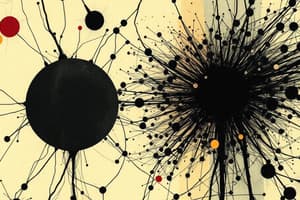Podcast
Questions and Answers
Which of the following microscopes is primarily used to visualize viruses?
Which of the following microscopes is primarily used to visualize viruses?
What type of rays are used as a source of light in a fluorescent microscope?
What type of rays are used as a source of light in a fluorescent microscope?
What unique capability does a fluorescent microscope offer compared to an electron microscope?
What unique capability does a fluorescent microscope offer compared to an electron microscope?
Which of the following is NOT a typical feature of a fluorescent microscope?
Which of the following is NOT a typical feature of a fluorescent microscope?
Signup and view all the answers
What is a common use of dyes in a fluorescent microscope?
What is a common use of dyes in a fluorescent microscope?
Signup and view all the answers
What distinguishes the differential gram stain technique from other staining methods?
What distinguishes the differential gram stain technique from other staining methods?
Signup and view all the answers
Which of the following statements is true regarding the differential gram stain?
Which of the following statements is true regarding the differential gram stain?
Signup and view all the answers
Which characteristic of bacteria is primarily assessed to determine the gram classification?
Which characteristic of bacteria is primarily assessed to determine the gram classification?
Signup and view all the answers
What role does peptidoglycan play in the gram staining process?
What role does peptidoglycan play in the gram staining process?
Signup and view all the answers
The differential gram stain primarily helps in identifying what type of microorganism?
The differential gram stain primarily helps in identifying what type of microorganism?
Signup and view all the answers
Which of the following bacterial examples belongs to the Gram-positive bacilli category?
Which of the following bacterial examples belongs to the Gram-positive bacilli category?
Signup and view all the answers
Which of the following is NOT a type of bacterial morphology mentioned?
Which of the following is NOT a type of bacterial morphology mentioned?
Signup and view all the answers
Among the following options, which one is characterized as a Gram-positive bacilli?
Among the following options, which one is characterized as a Gram-positive bacilli?
Signup and view all the answers
Which one of the following bacteria does not fall under the category of spirochete or spirillum?
Which one of the following bacteria does not fall under the category of spirochete or spirillum?
Signup and view all the answers
Which two of the following are distinct bacterial morphologies?
Which two of the following are distinct bacterial morphologies?
Signup and view all the answers
Which of the following is an example of Gram-negative cocci?
Which of the following is an example of Gram-negative cocci?
Signup and view all the answers
What is the decolorizing agent used in the staining procedure for Gram-negative bacteria?
What is the decolorizing agent used in the staining procedure for Gram-negative bacteria?
Signup and view all the answers
Which of the following bacteria is not classified as a Gram-negative cocci?
Which of the following bacteria is not classified as a Gram-negative cocci?
Signup and view all the answers
Which of the following is a characteristic of Gram-negative bacteria?
Which of the following is a characteristic of Gram-negative bacteria?
Signup and view all the answers
Haemophilus and Bordetella are examples of which type of bacteria?
Haemophilus and Bordetella are examples of which type of bacteria?
Signup and view all the answers
What does the identification and quantification of RNA or DNA specifically measure?
What does the identification and quantification of RNA or DNA specifically measure?
Signup and view all the answers
Which of the following best describes the process of quantifying RNA or DNA?
Which of the following best describes the process of quantifying RNA or DNA?
Signup and view all the answers
Why is it important to identify RNA or DNA in a biological sample?
Why is it important to identify RNA or DNA in a biological sample?
Signup and view all the answers
What type of organisms are primarily studied through the identification of RNA or DNA?
What type of organisms are primarily studied through the identification of RNA or DNA?
Signup and view all the answers
Which method is typically used for quantifying viral RNA or DNA in a sample?
Which method is typically used for quantifying viral RNA or DNA in a sample?
Signup and view all the answers
Study Notes
Microscopy Techniques
- Electron microscope and fluorescent microscope are used to visualize viruses.
- Electron microscope uses ultraviolet rays as a light source.
- Fluorescent microscope utilizes certain dyes like Chain & pairs.
Gram Staining
- Gram staining differentiates bacteria based on their cell wall structure.
- Peptidoglycan thickness of the cell wall determines the outcome of the staining.
- Gram-negative cocci include Neisseria, Haemophilus, and Bordetella.
- 95% ethyl alcohol acts as the decolorizing agent in the staining process.
Bacterial Morphologies
- Gram-positive bacilli include Corynebacteria, Bacillus, and Clostridium.
- Spirochete and spirillum are two other bacterial morphologies.
Viral Load Measurement
- RNA or DNA identification and quantification determines the viral load.
Studying That Suits You
Use AI to generate personalized quizzes and flashcards to suit your learning preferences.
Related Documents
Description
This quiz covers essential microbiology techniques, including microscopy methods used to visualize viruses, the process of Gram staining for bacteria, and the identification of bacterial morphologies. It also delves into how viral load is measured through RNA or DNA quantification. Test your knowledge on these crucial microbiological techniques!




